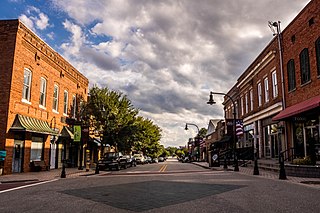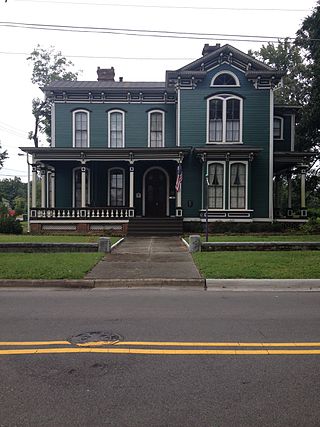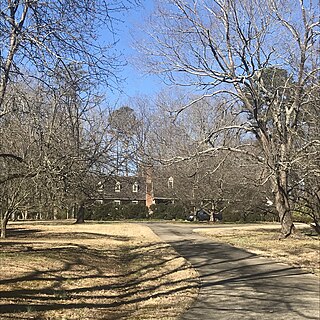
Oxford is a town in Granville County, North Carolina, United States, with a population of 8,628 as of the 2020 census. It is the county seat of Granville County.

Wake Forest is a town in Franklin, Granville and Wake counties in the U.S. state of North Carolina; located almost entirely in Wake County, it lies just north of the state capital, Raleigh. At the 2020 census, the population was 47,601. That is up from 30,117 in 2010, up from 12,588 in 2000. The U.S. Census Bureau estimates the city's population to be 47,601 as of April 1, 2020. In 2007, the town was listed by Forbes magazine as the 20th fastest growing suburb in America, with a 73.2 percent increase in population between 2000 and 2006. Wake Forest was the original home of Wake Forest University for 122 years before it moved to Winston-Salem in 1956.

The North Carolina State Capitol is the former seat of the legislature of the U.S. state of North Carolina which housed all of the state's government until 1888. The Supreme Court and State Library moved into a separate building in 1888, and the General Assembly moved into the State Legislative Building in 1963. Today, the governor and his immediate staff occupy offices on the first floor of the Capitol.

J. S. Dorton Arena is a 7,610-seat multi-purpose arena located in Raleigh, North Carolina, on the grounds of the North Carolina State Fair. It opened in 1952.

Monte Corwin Towe is an American basketball coach and retired basketball player. He was a starting point guard on the 1973–74 North Carolina State Wolfpack men's basketball team which won the NCAA Division I Men's Basketball Championship. At five feet seven inches, Towe is also one of the ten shortest players in NBA history.

Hope Plantation, built in 1803, is an early house built in the Palladian mode of the federal style, located on the Carolina Coastal Plain, near Windsor, North Carolina, in the United States. The plantation house was built by David Stone, a member of the coastal Carolina planter class, later Governor of North Carolina and a United States senator. One of the finest examples of Palladian design built in timber, the manor house is slightly modified by neo-classical elements. The facade has five bays and a pedimented double portico with the original Chinese Chippendale balustrade. Crowning the house is a widow's walk with matching railing. The interior of the house displays a height and grandeur rare in the region, and is furnished with a unique collection of period furniture, art and artifacts.
Richard Sharp Smith was an English-born American architect, noted for his association with George W. Vanderbilt's Biltmore Estate and Asheville, North Carolina. Smith worked for some of America's important architectural firms of the late 19th century—Richard Morris Hunt, Bradford Lee Gilbert, and Reid & Reid—before establishing his practice in Asheville. His most significant body of work is in Asheville and Western North Carolina, including dozens of buildings that are listed on the National Register of Historic Places or are contributing structures to National Register Historic Districts.

The Crabtree Jones House, also known historically as the Nathaniel Jones Jr. House, is a residence at 3108 Hillmer Drive in Raleigh, North Carolina. Constructed around 1808-1811 by Nathaniel Jones, it is one of the few remaining large scale plantation homes in Wake County, and one of the oldest private residences in Raleigh. The home has received several additions since its initial construction, but is mainly known for its Federal-style front. Owned by the Jones family for more than 150 years, the house has fallen into disrepair in more recent decades. Following the purchase of the land the house sat upon by developers in 2012, Preservation North Carolina acquired the house and had it moved to a nearby residential neighborhood, where it sits today. The Crabtree Jones house was greatly influenced by the historical events it stood through while in turn influencing the way the Raleigh community developed around it, through both its people and through its land.
The following is a timeline of the history of the city of Durham, North Carolina, USA.

The Solomon and Henry Weil Houses are two historic homes located at Goldsboro, Wayne County, North Carolina. They were built in 1875 for two brothers, and are nearly identical two-story, rectangular, Late Victorian frame dwellings. They feature projecting bays, bay windows, porches, and verandahs. Social activist Gertrude Weil, Henry's daughter, grew up in the house at 200 W. Chestnut St.
The 1924 North Carolina Tar Heels football team represented the University of North Carolina during the 1924 college football season as a member of the Southern Conference (SoCon). The Tar Heels were led by head coaches Bob Fetzer and Bill Fetzer in their fourth season and finished with a record of four wins and five losses.
The 1928 North Carolina Tar Heels football team represented the University of North Carolina during the 1928 college football season as a member of the Southern Conference (SoCon). The Tar Heels were led by head coach Chuck Collins in his third season and finished with a record of five wins, three losses, and two ties.
The 1920 North Carolina Tar Heels football team represented the University of North Carolina in the 1920 college football season.
The 1967 North Carolina Tar Heels football team represented the University of North Carolina at Chapel Hill during the 1967 NCAA University Division football season. The Tar Heels were led by first-year head coach Bill Dooley and played their home games at Kenan Memorial Stadium in Chapel Hill, North Carolina.
The 1938 North Carolina Tar Heels football team represented the University of North Carolina at Chapel Hill during the 1938 college football season. The Tar Heels were led by third-year head coach Raymond Wolf and played their home games at Kenan Memorial Stadium. They competed as a member of the Southern Conference.
The 1934 North Carolina Tar Heels football team represented the University of North Carolina at Chapel Hill during the 1934 college football season. The Tar Heels were led by first-year head coach Carl Snavely and played their home games at Kenan Memorial Stadium. They competed as a member of the Southern Conference, finishing with an undefeated conference record of 2–0–1. North Carolina claims a conference championship for 1934, although the official conference champion is Washington and Lee, who finished 4–0–0.
The 1933 North Carolina Tar Heels football team represented the University of North Carolina at Chapel Hill during the 1933 college football season. The Tar Heels were led by eighth-year head coach Chuck Collins and played their home games at Kenan Memorial Stadium. They competed as a member of the Southern Conference. Collins' coaching contract expired at the conclusion of the season, and UNC elected not to renew his contract, citing lack of success on the field. He was 38–31–9 in his eight seasons as head coach.
The 1931 North Carolina Tar Heels football team was an American football team that represented the University of North Carolina during the 1931 college football season as a member of the Southern Conference. In their sixth year under head coach Chuck Collins, the team compiled an overall record of 4–3–3, with a mark of 2–3–3 in conference play.

Green Hill, or Greenhill, is a Federal style plantation house in Hillsborough, North Carolina. The house originally sat on a plantation near Turkey Farm Road, which was given in a land grant by George II of Great Britain to Charles Wilson Johnston. The house was moved to a new location in the late 1960s.

Lincoln Heights School was a historic six-teacher Rosenwald School. Built-in 1924, the buildings of the school are now listed with National Register of Historic Places for its significance in education of African American children across Wilkes County, North Carolina.













